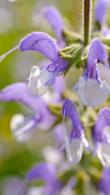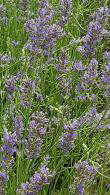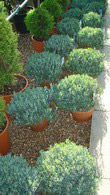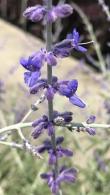Salvia Uliginosa Bog Sage
Pretty Sky-Blue Sage
1. Add items to basket
2. Go to the basket
3. Enter your postcode in Delivery Price Check
Pot size: 0.5 Litres
Plant ID: 13037 1


Salvia Uliginosa is a pretty sky-blue deciduous salvia. It holds the RHS AGM and suits mixed flower beds.
Salvia Uliginosa is native to the damp areas of South America hence its more common name Bog Sage. It’s a tough perennial with bright-green lanced-shaped leaves that are slightly sticky on tall branching stems. The foliage is scented when rubbed and it can be used in place of culinary sage. In late summer to autumn numerous two lipped sky-blue flowers bloom on towering spikes reaching metres in height. The individual flowers measure around 2 cms in length and last from July to the end of September if regularly deadheaded. The flowers are attractive to bees and it holds the RHS Perfect for Pollinators badge.
In winter Bog Sage dies down to the ground and remerges in spring.
Height And Spread of Salvia Uliginosa
Bog Sage can reach a height of two metres and a metre in spread.
How Hardy Is Salvia Uliginosa
This is a hardy salvia in the UK if the roots are well drained. It can be a little frost tender in more northerly areas and benefits from a protective layer of mulch on the crown in winter.
How To Use Salvia Uliginosa
This is a good choice of perennial to add late summer colour to cottage gardens, borders and rockeries. It brings beautiful colour and unstructured height to the back of mixed flower border where its soft blue tones mix well with pinks, yellows and whites.
Salvias suit a wildlife-friendly garden and as its foliage can be used in cooking it suits a kitchen garden too.
You can grow Bog Sage in plant containers on the patio or on balconies but it must not be allowed to dry out.
How To Care for Salvia Uliginosa
Salvia Uliginosa prefers a sunny spot but unlike other salvias must be kept consistently moist. Its native habitats are bogs and the edge of watercourses so it needs moist but well drained soils.
There is no need to prune as it dies back each year, but regular deadheading will encourage more flowers.
Cover the crown with compost mulch to protect it against frosts and keep the soil moist in the growing season.











